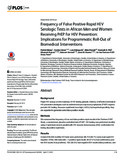Frequency of false positive rapid HIV serologic tests in African men and women receiving prep for HIV prevention: implications for programmatic roll-out of biomedical interventions
| dc.contributor.author | Ndase, Patrick | |
| dc.contributor.author | Celum, Connie | |
| dc.contributor.author | Kidoguchi, Lara | |
| dc.contributor.author | Ronald, Allan | |
| dc.contributor.author | Fife, Kenneth H | |
| dc.contributor.author | Bukusi, Elizabeth | |
| dc.contributor.author | Donnell, Deborah | |
| dc.contributor.author | Baeten, Jared M. | |
| dc.date.accessioned | 2015-06-04T06:30:19Z | |
| dc.date.available | 2015-06-04T06:30:19Z | |
| dc.date.issued | 2015-04-17 | |
| dc.identifier.citation | PLoS One. 2015; 10(4): e0123005 | en_US |
| dc.identifier.uri | http://hdl.handle.net/11295/84173 | |
| dc.description.abstract | Background Rapid HIV assays are the mainstay of HIV testing globally. Delivery of effective biomedical HIV prevention strategies such as antiretroviral pre-exposure prophylaxis (PrEP) requires periodic HIV testing. Because rapid tests have high ( > 95%) but imperfect specificity, they are expected to generate some false positive results. Methods We assessed the frequency of true and false positive rapid results in the Partners PrEP Study, a randomized, placebo-controlled trial of PrEP. HIV testing was performed monthly using 2 rapid tests done in parallel with HIV enzyme immunoassay (EIA) confirmation fol- lowing all positive rapid tests. Results A total of 99,009 monthly HIV tests were performed; 98,743 (99.7%) were dual-rapid HIV negative. Of the 266 visits with 1 positive rapid result, 99 (37.2%) had confirmatory posi- tive EIA results (true positives), 155 (58.3%) had negative EIA results (false positives), and | en_US |
| dc.language.iso | en | en_US |
| dc.publisher | University of Nairobi | en_US |
| dc.title | Frequency of false positive rapid HIV serologic tests in African men and women receiving prep for HIV prevention: implications for programmatic roll-out of biomedical interventions | en_US |
| dc.type | Article | en_US |
| dc.type.material | en_US | en_US |
Files in this item
This item appears in the following Collection(s)
-
Faculty of Health Sciences (FHS) [10378]

